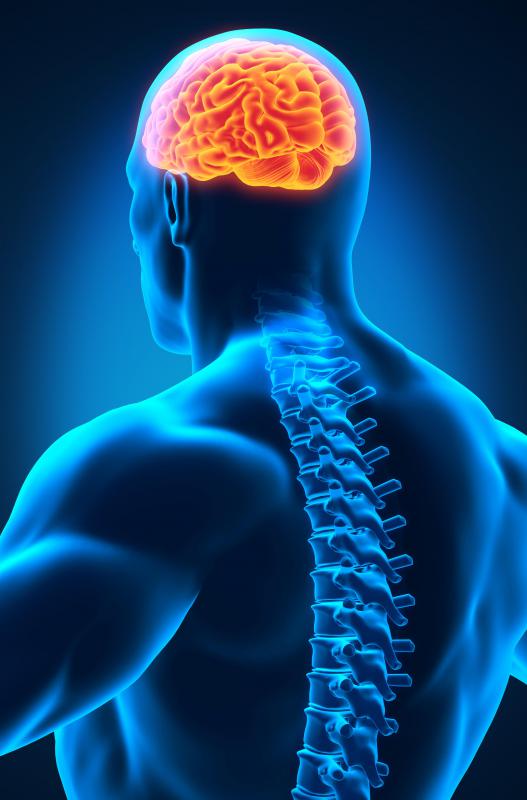At TheHealthBoard, we're committed to delivering accurate, trustworthy information. Our expert-authored content is rigorously fact-checked and sourced from credible authorities. Discover how we uphold the highest standards in providing you with reliable knowledge.
What are Melanocytes?
Melanocytes are cells that produce melanin, a dark pigment responsible for the coloration of hair and skin. Melanin serves a number of functions in the body and these cells are found in all people. Coloration of hair and skin is determined not by how many melanocytes someone has, but how active these cells are. With conditions like albinism, for example, these cells are present, but their activity is inhibited and they do not produce pigment.
In addition to being found in the skin, melanocytes are also present in the brain, inner ear, heart, and eye, among other locations in the body. They usually are buried below the surface. The cells produce melanin in response to environmental cues, including exposure to ultraviolet radiation and certain chemicals. The melanin travels out of the melanocytes and up to the surface of the tissue where the cells are found. Over time, it breaks down and needs to be replaced with fresh supplies of melanin produced by the layer of underlying melanocytes.

Pigmentation disorders, including congenital conditions, as well as acquired ones, can impact the way melanocytes work. Some suppress activity on the part of these cells, causing pale or white patches to appear on the body in locations where no melanin is being made. Others do the opposite, stimulating overproduction of melanin and causing darkening of the skin. Certain medications have the same effect, explaining why people on some prescriptions develop darkened skin.

In the skin, melanin has a protective quality. This pigment absorbs ultraviolet radiation, preventing it from traveling to the surrounding tissues of the body. As a result, people from regions where sun exposure is frequent and intense often have more active melanocytes. The cells work to ensure that their bodies have a healthy layer of melanin so they are less likely to burn and suffer UV damage to the sun.

Melanin also plays some other roles in the body, including the brain, where it appears to be a source for the basic ingredients for some neurotransmitters. The brain needs to synthesize chemicals as it runs out of them and in people with limited melanin production in the brain, reductions in some neurotransmitters have been observed. People with degenerative brain diseases may also experience destruction of melanocytes and subsequent declines in melanin function, which lead to decreased brain function. The area of the brain known as the substantia nigra is named for the high levels of melanin it contains.
AS FEATURED ON:
AS FEATURED ON:















Discussion Comments
I knew a kid in school with albinism. He had white hair and pink eyes. Some people were afraid of him, but I found him fascinating. I became his first friend at our school.
When we entered high school, we had biology class together, and our teacher educated everyone on albinism. The condition is caused by altered genes that cannot allow a person to produce melanin as they should.
We learned that my friend has pink eyes not because his iris is actually pink, but because the lack of color in the iris lets his blood vessels within his eye show through. He had extreme albinism, but some people with mild cases have blue or even brownish or purple eyes.
When learning about freckles in biology class, we viewed a diagram of a melanocyte under the skin. It had tentacles that reached up to distribute the melanin.
Freckles are patches of melanin that have accumulated in a certain area. I have lots of them, and I develop more each time I am exposed to the sun for long periods.
I have one birthmark I consider to be a giant freckle. It is on the inside of my knee, and the melanocytes of that area must have really been active before I was born, because it is noticeably darker. The freckles are scattered across a region about the width of a softball.
I can just picture the melanocytes competing with each other to shoot melanin upwards. They had to have been closely packed to achieve what they did.
My cousin has struggled with obesity all his life. When he got up to four hundred pounds, he went to a doctor to see if some underlying condition was causing his weight gain.
The doctor told him that a melanocyte stimulating hormone that works to suppress the appetite is present in the brain. In many people who battle obesity, the brain receptor for this hormone has a mutation. That makes these people unable to respond to the melanocyte stimulating hormone.
His doctor discovered that his brain receptor for this hormone was, in fact, defective. It made him feel better to know that his obesity wasn't all his fault.
My melanocytes must not be very active, because I have pale skin and light brown hair. I do give them a workout in the summer when I spend most of my free time in the pool.
Though the development of my layer of melanin usually includes a sunburn along the way, I do notice that after my skin gets a tan color to it, I can spend more time in the sun before I burn.
I always wear sunscreen, but sometimes, the sun is just too intense for it to protect me fully. I am whiter than all of my friends, and I await the arrival of the season of melanin so that I may blend in better.
Post your comments